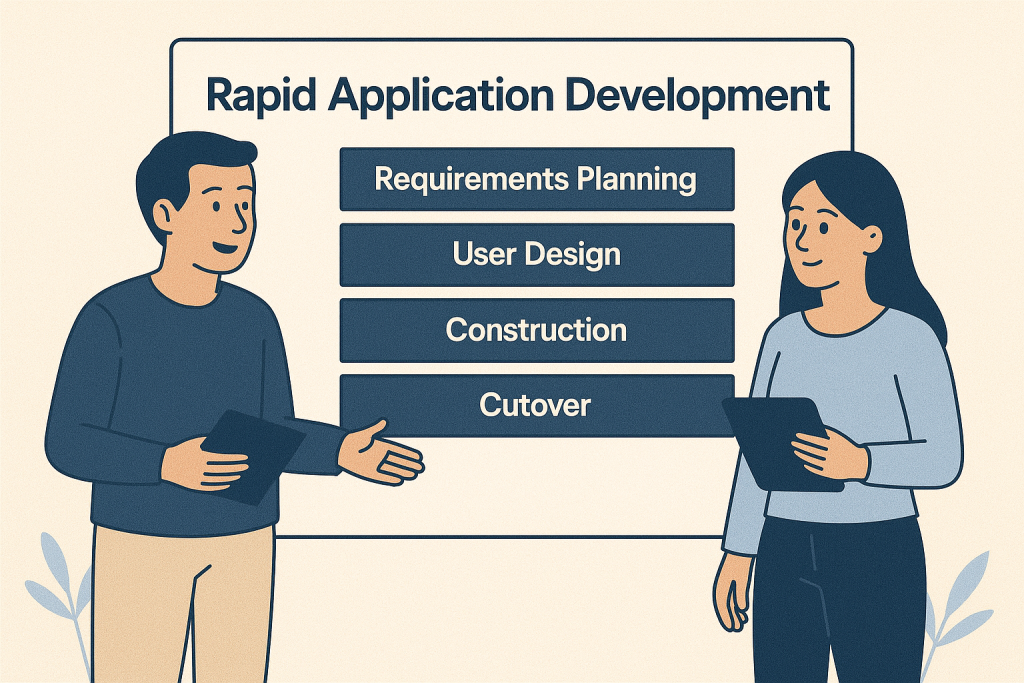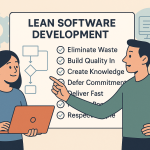What is Rapid Application Development (RAD)?
In the fast-paced world of software development, waiting months or years to deliver a finished product can mean the difference between market success and obsolescence. This reality has driven many organizations toward Rapid Application Development (RAD), a methodology that prioritizes speed, flexibility, and user feedback over traditional linear development approaches. Rather than following rigid, sequential processes, RAD embraces an iterative philosophy that treats software development as a collaborative, evolving conversation between developers and users.
Rapid Application Development represents a fundamental shift in how we think about building software. Instead of spending extensive time upfront trying to perfect requirements and design specifications, RAD acknowledges that the best way to understand what users really need is to put working software in their hands as quickly as possible. This approach recognizes that software, unlike physical products, can be modified and refined with relative ease and minimal cost.
The RAD methodology operates through four distinct but interconnected phases. Requirements planning serves as the initial foundation, where teams identify the broad scope and objectives of the project without getting bogged down in exhaustive detail. User design follows, involving end-users directly in creating prototypes and mockups that reflect their actual needs and preferences. The rapid construction phase transforms these designs into working software through iterative development cycles. Finally, the cutover phase handles deployment, user training, and the transition from development to production use.
This structure differs markedly from traditional waterfall approaches, where each phase must be completed before moving to the next. RAD phases often overlap and cycle back on themselves, creating a more organic development process that can adapt to changing requirements and new insights.
What is the History of Rapid Application Development?
The emergence of RAD in the early 1990s wasn’t accidental—it was a direct response to the frustrations many organizations experienced with waterfall development methodologies. James Martin’s seminal 1991 book “Rapid Application Development” crystallized ideas that had been percolating in the software development community for years. Developers and project managers were increasingly recognizing that the traditional approach of extensive upfront planning followed by lengthy development cycles often resulted in software that was outdated or misaligned with user needs by the time it reached production.
The waterfall model, borrowed from manufacturing and construction industries, assumed that software requirements could be fully understood and documented before development began. This assumption proved problematic in practice, as business needs evolved rapidly and users often couldn’t articulate their requirements until they saw working prototypes. RAD emerged as a more pragmatic approach that acknowledged these realities and built flexibility into the development process itself.
The timing of RAD’s introduction coincided with improvements in development tools and hardware that made rapid prototyping more feasible. Visual programming environments, fourth-generation programming languages, and increasingly powerful personal computers provided the technical foundation that made Martin’s vision practical for mainstream development teams.
What are the Strengths and Weakness of RAD?
The appeal of RAD lies in its ability to harness the unique characteristics of software development for competitive advantage. Unlike physical products, software can be modified, tested, and refined with remarkable speed and relatively low cost. RAD methodologies capitalize on this flexibility by creating tight feedback loops between developers and users, ensuring that the final product closely matches actual needs rather than initial assumptions.
This iterative approach offers several compelling benefits:
• Accelerated delivery and continuous improvement: The methodology takes full advantage of software’s inherent flexibility, allowing organizations to iterate rapidly and at low cost, which enables continuous product enhancement and faster market response
• Enhanced project management: Large, overwhelming projects become manageable when broken down into smaller, discrete tasks that teams can tackle systematically
• Reduced time-to-value: Users receive functional software much sooner than with traditional approaches, providing immediate business value and early return on investment
The collaborative nature of RAD also tends to improve communication between technical teams and business stakeholders. When users can interact with working prototypes, they can provide more specific and actionable feedback than they might offer when reviewing written specifications or static mockups.
Despite its advantages, RAD presents significant challenges that organizations must carefully consider. The methodology places demanding requirements on both development teams and user communities that not all organizations can meet effectively:
• High skill requirements: Success depends on having exceptionally skilled developers and designers who can work effectively in ambiguous, rapidly changing environments
• Intensive user commitment: The approach demands sustained involvement from users throughout every stage of development, requiring significant time investment from busy stakeholders
• Scale limitations: RAD becomes increasingly difficult to manage as project size and complexity grow, making it less suitable for large-scale enterprise implementations
The user involvement that makes RAD effective also represents one of its primary challenges. Organizations must identify users who can commit significant time throughout the development process and who possess both domain expertise and the communication skills necessary to provide useful feedback. This level of engagement can be difficult to sustain, particularly in organizations where potential users have demanding operational responsibilities.
Should You Use Rapid Application Development?
Choosing whether to adopt RAD requires honest assessment of both organizational capabilities and project characteristics. The methodology works best when certain conditions align: a skilled, experienced development team comfortable with ambiguity; users who can commit to active participation throughout the project; and a project scope that’s focused enough to benefit from rapid iteration without becoming overwhelmed by complexity.
RAD particularly suits organizations operating in competitive markets where speed to market provides significant advantage, or where user requirements are expected to evolve rapidly. Companies developing customer-facing applications, internal productivity tools, or software addressing emerging market needs often find RAD’s flexibility invaluable. The approach also works well when existing systems need rapid enhancement or when pilot projects are being developed to test new concepts.
However, RAD may not be appropriate for projects with rigid regulatory requirements, where extensive documentation and formal approval processes are mandatory. Similarly, organizations lacking experienced development teams or those unable to secure committed user involvement may find traditional methodologies more suitable, even if they take longer to deliver results. Large-scale software development projects with complex integration requirements and multiple stakeholder groups often exceed RAD’s effective scope.
The framework offers strong benefits to teams familiar with agile philosophy, working on relatively small projects, and having customers or users willing to commit to deep involvement throughout the entire development process. When these conditions aren’t met—whether due to project scale, team capabilities, or user availability—alternative approaches may prove more effective despite their longer development cycles.
The decision ultimately comes down to matching methodology to context. RAD represents a powerful approach for organizations that can meet its requirements and operate in environments where its strengths provide meaningful competitive advantage. The key lies in recognizing when those conditions exist and having the organizational maturity to execute the methodology effectively, while also understanding when the constraints and limitations make other approaches more practical.
Rapid Application Development emerged from practical frustrations with traditional software development approaches and has evolved into a sophisticated methodology that acknowledges the unique characteristics of software as a medium. Its emphasis on iteration, user involvement, and flexibility has proven valuable for many organizations, particularly those operating in dynamic environments where user needs and market conditions change rapidly. However, RAD’s success depends heavily on having the right combination of skilled teams, engaged users, and appropriate project scope, making careful evaluation of these factors essential before adoption.
Conclusion
Rapid Application Development represents both an evolution in software development thinking and a practical response to the limitations of traditional methodologies. While it offers compelling advantages in speed, user satisfaction, and adaptability, these benefits come with specific requirements and constraints that organizations must carefully evaluate. The methodology’s emphasis on collaboration, iteration, and rapid feedback remains as relevant today as when James Martin first articulated these principles over three decades ago. For teams that can meet its demands—skilled developers, committed users, and appropriately scoped projects—RAD provides a powerful framework for creating software that truly serves user needs in rapidly changing environments.


